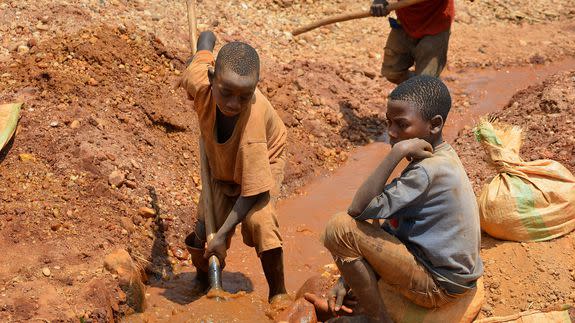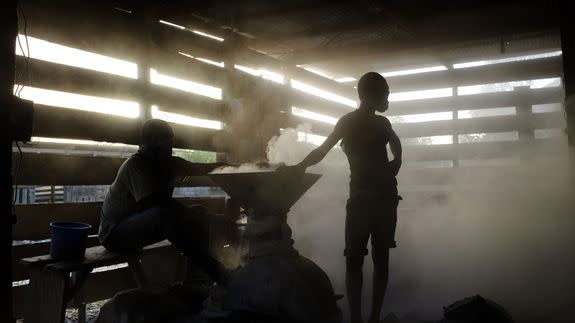4 ways you can help curb the tech industry's child labor problem

The device you're using to read this story may have its roots in child labor.
In a society infatuated with tech, we rarely stop to think about how that tech is made. But many of the little parts that make up your favorite high-tech devices, advocates say, lead to a massive global inequality for children.
SEE ALSO: 6 crucial facts about human trafficking — and how you can help
Joost Kooijmans, a child labor specialist with UNICEF, says that some of the most serious child labor concerns are with the mining of raw materials that go into high-tech products.
"There is gold inside your phone. There is cobalt inside the lithium battery. There's coltan that's used in the miniature circuitry in your phone," he tells Mashable. "These are minerals that are being mined in areas where law enforcement and government oversight is very weak — and what you find is that a lot of children end up going to work in these regions."
Children often work in mines because they're small, able to squeeze into tiny tunnels to harvest minerals. It's dangerous work due to unsafe conditions, like tunnel collapses and toxic chemicals in the air.
"It's not just that it's child labor and that these children are missing school and they are missing their childhoods," says Reid Maki, director of child labor advocacy and coordinator for the Child Labor Coalition. "These children are suffering life-long neurological damage and health problems that are just astounding. And it has to stop."
July 30 is World Day Against Trafficking in Persons, a day to raise awareness of human trafficking and promote its abolition. Though many people immediately think of sex trafficking when they hear human trafficking, forced labor is far more common — and that includes child labor.
An estimated 1 million children work in mines around the globe, often collecting minerals and gold in Africa, Asia and South America. A high concentration of natural resources in these regions, along with poverty that forces children into work, completes a concerning pipeline.
Maki believes it's possible for the tech industry to move away from child labor while still producing the devices we love. He admits, though, that companies will have to let go of some of their profits to do so.
"These companies are making billions and billions of dollars," Maki says. "But they are making it on the backs of children."
Though Maki is critical of the industry and works full-time to curb child labor practices, he does own a smartphone. Often, the result is a helpless feeling.
"I'd love to be able to do something or avoid buying a smartphone that is made using child labor," Maki says. "But I can't. It's really impossible."
But now that you know your favorite tech may be intertwined with child labor practices, what do you do?
Tech's child labor issue is going to take a lot of work to tackle — and that can feel largely out of a consumer's hands. But there are tangible steps you can take to curb your role, even if you can't entirely disconnect.
1. See what tech companies are doing — and demand transparency.
Largely due to increased pressure from advocates, many tech companies are tackling the issue of child labor in their supply chain. But their findings and work aren't always public knowledge.
Companies like Apple, Microsoft, Intel and Samsung do tackle the issue of concerning labor practices with public reports, which disclose what the companies are doing to address child labor in their supply chains. But both Kooijmans and Maki say that public transparency via these reports probably isn't at its peak, partially because the majority of consumers aren't demanding this type of information on their devices.
"If even half the people who own smartphones spoke up and said, 'You know, I'm really worried about these kids mining these minerals in my cellphone,' I really think that would get companies' attention," Maki says. "If there were enough evidence of consumer concern, the company would then be forced to take the lead on that."
Kooijmans suggests contacting the companies behind your favorite devices and asking one simple question: "What are you doing about these issues that exist in the supply chain?" Researching the companies' public releases and pressing for more information will help illuminate how much your tech consumption is tied to concerning labor practices.
Maki says that while simply expressing concern may not seem like it's doing much for the average person, enough people demanding change can — and will — make a difference.
"I'm a believer in making your voice heard — even though it's not always easy to do," he says.
2. Donate to organizations working to end child labor.

Image: UNICEF/UNI190048/Quarmyne
While it can seem overwhelming to tackle child labor as an individual, many organizations have dedicated their efforts to curbing the issue. If you have the financial means, donating to this work is one massive way you can help directly reach children who need support.
Organizations like the Free the Slaves and UNICEF work on the ground in regions where children are especially vulnerable to child labor, working to address the problem. The Stop Child Labor Coalition is a collection of 34 of the globe's top child labor organizations, all working together to tackle the issue aggressively.
3. Educate yourself on contributing issues.
Child labor is such a complex issue, partially because it hinges on so many other global inequalities. High rates of poverty and lack of access to education are two of the most noticeable inequalities that fuel child labor. In order to tackle the issue comprehensively, these contributing issues need to be addressed.
"The reason why children work is because education systems fail or maybe there are no schools," Kooijmans says. "Mining attracts a lot of [children in poverty] because it pays relatively well."
Educate yourself on the general well-being of children globally. You can learn more about the issues facing children around the world at UNICEF, Plan International and Human Rights Watch.
To find out more about products produced with child labor, download the Sweat & Toil app by the U.S. Department of Labor, which breaks down the global reality of forced labor.
4. Recognize that this issue runs deeper than just tech.
Child labor may be an issue the tech industry needs to confront, but it isn't limited to high-tech devices. Child labor is present in countless industries, from clothing to jewelry to food. This means the practice touches your everyday life — and almost endlessly.
To fully advocate for an end to child labor in tech, it's crucial to advocate for an end to child labor in all industries, an express a larger discontent with the supply chain of the products we use and consume.
"We need to become more vocal and more demanding," Kooijmans says. "We need to say we don't accept these kinds of deplorable practices that exist."
